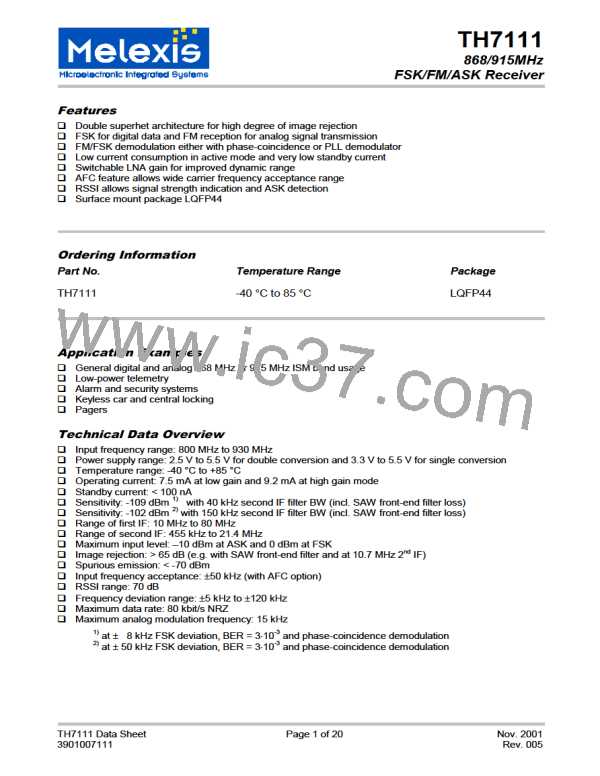TH7111
868/915MHz
FSK/FM/ASK Receiver
Frequency Planning
Frequency planning is straightforward for single-conversion applications because there is only one IF that
might be chosen, and then the only possible choice is low-side or high-side injection of the LO1 signal (which
is now the one and only LO signal in the receiver).
The receiver’s double-conversion architecture requires careful frequency planning. Besides the desired RF
input signal, there are a number of spurious signals that may cause an undesired response at the output.
Among them are the image of the RF signal (that must be suppressed by the RF front-end filter), spurious
signals injected to the first IF (IF1) and their images which could be mixed down to the same second IF (IF2)
as the desired RF signal (they must be suppressed by the LC filter at IF1 and/or by low-crosstalk design).
By configuring the TH7111 for double conversion and using its internal PLL synthesizer with fixed feedback
divider ratios of N1 = 16 (DIV_16) and N2 = 2 (DIV_2), four types of down-conversion are possible: low-side
injection of LO1 and LO2 (low-low), LO1 low-side and LO2 high-side (low-high), LO1 high-side and LO2
low-side (high-low) or LO1 and LO2 high-side (high-high). The following table summarizes some equations
that are useful to calculate the crystal reference frequency (REF), the first IF (IF1) and the VCO1 or first LO
frequency (LO1), respectively, for a given RF and second IF (IF2).
Injection type
high-high
low-low
high-low
low-high
REF
LO1
IF1
(RF – IF2)/30
32•REF
(RF – IF2)/34
32•REF
(RF + IF2)/30
32•REF
(RF + IF2)/34
32•REF
LO1 – RF
2•REF
RF – LO1
2•REF
LO1 – RF
2•REF
RF – LO1
2•REF
LO2
IF2
LO2 – IF1
IF1 – LO2
IF1 – LO2
LO2 – IF1
The following table depicts generated, desired, possible images and some undesired signals considering the
examples of 868.3 MHz and 915 MHz RF reception at IF2 = 10.7 MHz.
Signal type
RF =
RF =
RF =
RF =
RF = 915
MHz
RF = 915
MHz
RF = 915
MHz
RF = 915
MHz
868.3 MHz 868.3 MHz 868.3 MHz 868.3 MHz
Injection type
high-high
high-low
low-high
high-high
30.14333
high-low
low-high
low-low
low-low
REF / MHz
LO1 / MHz
IF1 / MHz
LO2 / MHz
28.58667
914.77333
46.47333
57.17333
29.3
937.6
69.3
25.85294
30.85667
27.22647
25.22353
807.15294
61.14706
50.44706
746.00588
39.74706
26.59706
851.10588
63.89412
53.19412
787.21176
42.49412
827.29412 964.58667
987.41333 871.24706
41.00588
51.70588
786.28824
62.40588
49.58667
60.28667
1014.17
72.41333
61.71333
1059.83
43.75294
54.45294
827.49412
65.15294
58.6
RF image/MHz 961.24667
IF1 image/MHz 67.87333
1006.9
47.9
70.98667
51.01333
The selection of the reference crystal frequency is based on some assumptions. As for example: the first IF
and the image frequencies should not be in a radio band where strong interfering signals might occur
(because they could represent parasitic receiving signals), the LO1 signal should be in the range of 800 MHz
to 915 MHz (because this is the optimum frequency range of the VCO1). Furthermore the first IF should be
as high as possible to achieve highest RF image rejection. The columns in bold depict the selected frequency
plans to receive at 868.3 MHz and 915 MHz, respectively.
TH7111 Data Sheet
3901007111
Page 4 of 20
Nov. 2001
Rev. 005

 ETC [ ETC ]
ETC [ ETC ]